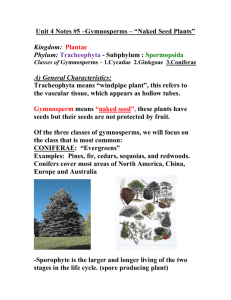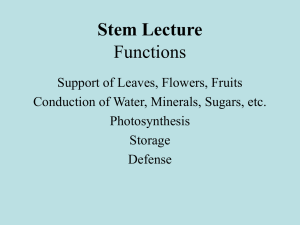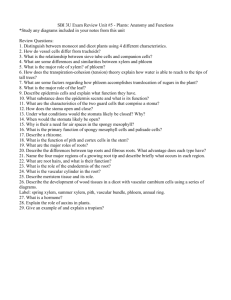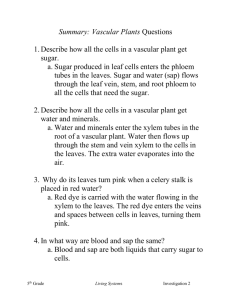1 OBJECTIVE SHEET PLANTS Phylum: Coniferophyta
advertisement
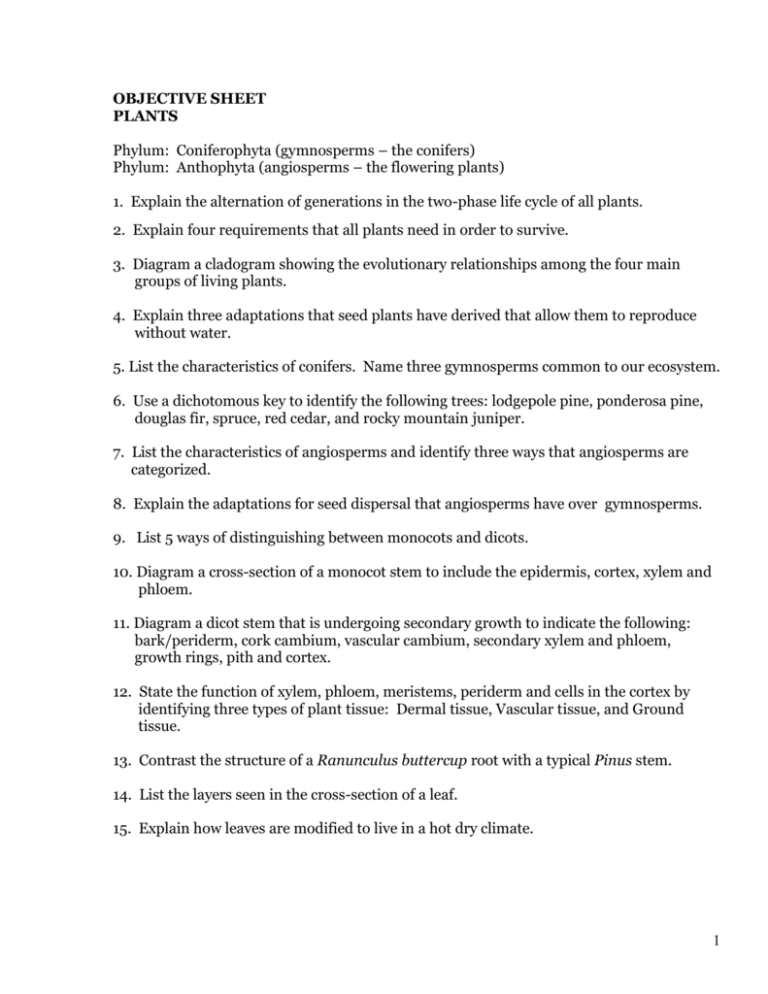
OBJECTIVE SHEET PLANTS Phylum: Coniferophyta (gymnosperms – the conifers) Phylum: Anthophyta (angiosperms – the flowering plants) 1. Explain the alternation of generations in the two-phase life cycle of all plants. 2. Explain four requirements that all plants need in order to survive. 3. Diagram a cladogram showing the evolutionary relationships among the four main groups of living plants. 4. Explain three adaptations that seed plants have derived that allow them to reproduce without water. 5. List the characteristics of conifers. Name three gymnosperms common to our ecosystem. 6. Use a dichotomous key to identify the following trees: lodgepole pine, ponderosa pine, douglas fir, spruce, red cedar, and rocky mountain juniper. 7. List the characteristics of angiosperms and identify three ways that angiosperms are categorized. 8. Explain the adaptations for seed dispersal that angiosperms have over gymnosperms. 9. List 5 ways of distinguishing between monocots and dicots. 10. Diagram a cross-section of a monocot stem to include the epidermis, cortex, xylem and phloem. 11. Diagram a dicot stem that is undergoing secondary growth to indicate the following: bark/periderm, cork cambium, vascular cambium, secondary xylem and phloem, growth rings, pith and cortex. 12. State the function of xylem, phloem, meristems, periderm and cells in the cortex by identifying three types of plant tissue: Dermal tissue, Vascular tissue, and Ground tissue. 13. Contrast the structure of a Ranunculus buttercup root with a typical Pinus stem. 14. List the layers seen in the cross-section of a leaf. 15. Explain how leaves are modified to live in a hot dry climate. 1 16. Explain “Alternation of Generations” in gymnosperms by discussing the gymnosperm life-cycle. 17. Identify the structures in a typical flower. Include the anther, filament, stamen, stigma, style, ovary, carpal (pistil), sepal, petal, ovule, pollen, pollen tube, sperm nuclei, egg nuclei and polar nuclei. 18. Explain what occurs in double fertilization of angiosperms. Include the unique formation of a triploid cell in the formation of endosperm for the developing embryo. 2 Kingdom Plantae Plants dominate the landscape. Where plants are plentiful, other organisms such as animals, fungi, and microorganisms take hold and thrive. Plants provide the base for food chains on land. They also provide shade, shelter, and oxygen for animals of every size and kind. Plants are defined as _______________________________________________________ _______________________________________________________ 1. Draw a diagram of the Plant Life Cycle below: The generation of a plant that is diploid (2N) is called the ________________ and the generation of a plant that is haploid (N) is the __________________ The gametophyte produces _________________ and ________________ while the sporophyte produces _____________________. 2. Living on land requires special needs of all plants. These include: a) ___________________________________ b) ___________________________________ c) ___________________________________ d) ___________________________________ 3 3. Draw a cladogram below showing the evolutionary relationships among the four main groups of living plants. Mosses and their relatives lack __________________________ that all other plants have. The group of plants that do not have seeds include ____________________. The seeds of flowering plants differ from the seeds of cone-bearing plants because flowering plants have seeds ________________________________. 4. Seed plants have been divided into two main groups: the group that bears their seeds directly on the surfaces of cones are called ___________________ and the _______________________ that bear their seeds within a layer of tissue that protects the seed. Mosses and ferns are not as complex as the seed plants. Unlike mosses and ferns, seed plants do not require water for fertilization of gametes. Because of this method of development, seed plants can live just about anywhere from moist habitats that are often dominated by the seedless plants, to dry and cold habitats where most seedless plants cannot survive. 4 All seed plants have three main adaptations that allow them to survive and reproduce free from water. Adaptations that allow seed plants to reproduce without water include: ______________________________ ______________________________ ______________________________ 5. The word “gymnosperm” means _______________________________ The seed-bearing structures of gymnosperms are called _________________ By far the most common gymnosperm are the ________________________ Three common members of this phylum to this area include ______________ _______________________________________________________ 6. The leaves of conifers have specific adaptations to dry conditions and limited sunlight. The development of long, thin needles aids in several ways. This includes: _______________________________________________________ _______________________________________________________ _______________________________________________________ _______________________________________________________ 7. The name “angiosperm” means _______________________________ What is a flower? ___________________________________________ Why do angiosperms have a reproductive advantage over gymnosperms? _______________________________________________________ _______________________________________________________ _______________________________________________________ 5 The diversity of angiosperms is divided into three categories (that can overlap) that simply provide a way of organizing this varied group of plants. These include: _____________________________________________ _______________________________________________________ 8. Fill in the following to explain the differences between Monocots and Dicots: (you do not need to draw pictures) MONOCOTS DICOTS SEEDS LEAVES FLOWERS STEMS ROOTS In monocots, __________________________ are scattered throughout the stem. In dicots and most gymnosperms, vascular bundles are arranged in a cylinder. These vascular bundles contain vascular tissue. Plants are able to carry water and nutrients to all parts of the plant through the use of vascular tissue. Xylem cells are designed to transport water to all parts of the plant while cells that carry nutrients such as sugar are called Phloem cells. 9. Obtain a microscope for you and a partner to work with. Obtain the slide called “ MONOCOT & DICOT STEMS – c.s.” On the next page, diagram a simplified cross section. Label the epidermis, vascular bundles (include xylem, phloem), ground tissue, cortex and pith. Note that in dicot stems the vascular bundles are arranged in a ring whereas the bundles in monocots are scattered throughout the stem. Diagram a single vascular bundle showing xylem and phloem (blue band) 6 References include: Your text pg. 589-590 Botany text pg. 144, 145, 146, 147 Label on each stem: epidermis, vascular bundles, ground tissue, cortex and pith. Monocot stem Dicot stem Vascular bundle (label xylem + phloem) 7 Read the reference pages 579 from your text on seed plant structures as well as the 3 main tissue systems on reference pages 580-583. 10. Unlike animals where growth occurs all over the body, plants only grow at the stem, branch, and root tips. The tissues present in those areas are called meristems. Apical meristems are found in the end of stems, roots and branches. The meristematic tissues that make up these areas are made up of unspecialized or undifferentiated cells that give rise to new cells by mitosis. Once these cells are made, they differentiate into specialized cells that can do specific functions. For their entire life, new cells are produced at the tip of the roots and shoots. This method of growth, occurring only at the ends of a plant, is called primary growth. This increases the length of a plant from year to year. Look at the Coleus Leaf Tip slide to observe both apical and lateral meristem tissue. SECONDARY GROWTH IN DICOTYLEDONOUS STEMS If a plant is to grow taller and larger each year, its stem must increase in thickness as well as length. The method of growth in which stems increase in width is called secondary growth. Two other kinds of meristems are found inside stems that perform this; they are cork cambium and the vascular cambium. The vascular cambium becomes continuous between the vascular bundles. On the outside, it produces secondary phloem. The outermost phloem is crushed and does not form growth rings. Towards the inside of the stem, the vascular cambium produces 6 to 8 times as much secondary xylem as it does phloem. Thus the tree becomes more and more made of xylem (wood). The innermost xylem becomes plugged with resins and stops functioning and is now called heartwood. The outer still functioning xylem is called sapwood. 8 The spring xylem cells (C) are larger than the late summer xylem cells due to the difference in amounts of water available. The small late summer cells (D) are seen by your eye as a dark ring. The width of a lighter area and a dark ring is one year’s growth. The width of one year’s growth gives an indication of the growing conditions that were present during that year. (structures C and D below) 9 A tree can be killed by “girdling”, which is the cutting of the phloem around the circumference of a tree. This stops the sugar from the leaves from reaching the roots which causes the roots, and thus the whole tree to die. In woody stems, a layer of meristematic cells in the cortex becomes active ( the cork cambium) and makes a waterproof layer of cork, commonly called bark or periderm. As the tree grows, bark from underneath replaces old bark. 11. After reading text pgs. 591-593 on “Secondary Growth of Stems”, Obtain a slide called “PINUS- Older stem c.s., or use the slide called “MEDICAGO stem and diagram a ‘pie-shaped’ section of the stem and label: bark/periderm, cork cambium, vascular cambium, secondary xylem and phloem, growth rings, pith, and cortex. Reference pgs. Botany text pgs. 144-147 PINUS – Older stem c.s. 10 Tilia (Basswood) Stem Label the following structures on the diagram of a stem below: Cork, cork cambium, cortex region, secondary phloem, vascular cambium, secondary xylem, fall xylem, spring xylem, 1 year’s growth, pith 11 12. Copy the diagram of a RANUNCULUS (BUTTERCUP) root, c.s. from the white board. Obtain a slide of this from the front and identify the xylem in the centre. Identify the structures, xylem, phloem, cortex, starch, epidermis and endodermis. 12 13. Obtain a slide of “Ligustrum leaf, x.s. or Pelargonium leaf, x.s.. You need not draw it. Compare the actual appearance under the microscope to the diagram below. Be able to identify the various layers. What is the purpose of the holes in the leaf? _________________________ Note that guard cells have chloroplasts. What is the function of the vein? ________________________________________________________ Use this drawing to compare each structure to what you see in the slide of the leaf. Identify all of the structures for the plant exam. 13 Ligustrum leaf x.s. Label as many structures and layers as you can and check up front. Reference : your text pg. 597 14. Obtain a slide of “Sedum epidermis”. You are looking at a leaf viewed from the bottom surface called the lower epidermis. Note the stoma surrounded by guard cells. Sketch and label what you see below. The guard cells are the only cells on the lower epidermis that contain chloroplasts. 14 15. Label the Flower after you have read the definitions: anther - the tip of a flower’s stamen ( the male reproductive organ) the anther contains pollen filament - the stem of the anther (holds the anther) ovary - produces ovules. It is at the base of the pistil (the female reproductive organ petal - brightly coloured leafy structure that attracts insects sepal - small leaves located under the flower stigma - the uppermost part of the pistil. It receives pollen grains during pollination, when they travel through the style to the ovary. Style - the sticky top part of the pistil directly above the ovary. 15 Make sure that you have seen the model up front explaining double fertilization. Diagram the model below. Include the following terms: pollen, pollen tube, sperm nuclei, ovary, ovule, egg cell, and polar nuclei. Refer to page 614 in the text. Read about double fertilization on page 616. Diagram a seed as shown on page 616 of text and label the following parts: seed coat, endosperm, and embryo. 16 Plant Lab Exam Checklist Monocot stem Dicot stem Chloroplast Cortex Vascular bundle Double fertilization Primary xylem Primary phloem Seed coat Secondary xylem Secondary phloem Endosperm Vascular cambium Cork cambium Apical meristem Sapwood Pith Upper epidermis Lower epidermis Waxy cuticle Palisade layer Spongy mesophyll Guard cells Stoma(ta) Vein Spring xylem Fall xylem Growth ring Cotyledon Anther Periderm (bark) Stamen Seed pistil Ovary Ovule Stigma Style Filament Sepal Petal (corolla) Pollen Embryo Pollen tube Heartwood Sperm nuclei Polar nuclei Egg cell 17 18

